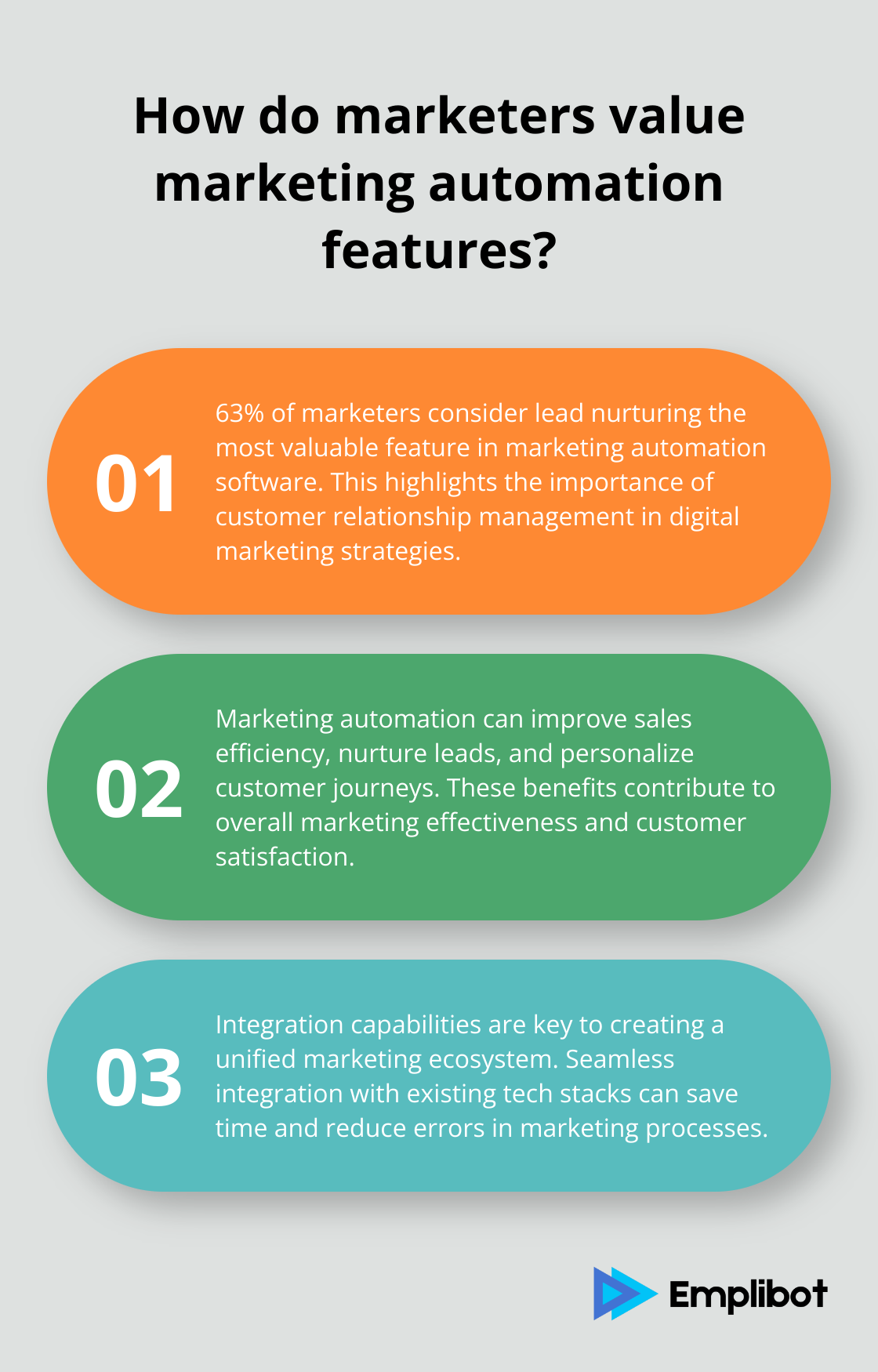Marketing automation has revolutionized how businesses engage with their customers. At Emplibot, we’ve seen firsthand how proper implementation can skyrocket efficiency and boost ROI.
However, many companies struggle with the marketing automation implementation steps. This guide will walk you through the essential processes to set up a successful marketing automation strategy, from defining goals to optimizing workflows.
How to Define Your Marketing Automation Strategy
Set Clear, Measurable Goals
The foundation of a successful marketing automation strategy lies in setting specific, measurable goals. Vague objectives won’t suffice. Instead, try to establish targets that align with your business objectives. A study by Ascend2 reveals that companies with clearly defined goals are 376% more likely to report success in their marketing automation efforts.
Identify Your Target Audience
A deep understanding of your target audience is essential. Create detailed buyer personas based on real data, not assumptions. Use tools such as Google Analytics, customer surveys, and social media insights to gather information. HubSpot’s research indicates that using buyer personas makes websites 2-5 times more effective and easier to use for targeted users.
Map Out the Customer Journey
After identifying your audience, map their journey from awareness to purchase (and beyond). This step proves critical for creating targeted, timely content. Salesforce reports that 79% of agents and 73% of mobile workers say they support more products and services than they did a year ago. Understanding each touchpoint allows you to create automated workflows that deliver the right message at the right time.
Align Automation with Business Objectives
Your marketing automation strategy should align with your overall business objectives. This alignment ensures that your automated efforts contribute directly to your company’s growth and success. Consider how each automated process will impact your bottom line and support your long-term business goals.
Plan for Scalability and Flexibility
As your business grows, your marketing automation needs will evolve. Plan for scalability from the outset. Choose tools and processes that can grow with your business. Additionally, build flexibility into your strategy. The most successful marketing automation strategies adapt to changing customer needs and market trends.

With a well-defined strategy in place, the next step is to select the right marketing automation tools to bring your plan to life. Let’s explore how to choose the best tools for your specific needs and goals.
How to Choose the Best Marketing Automation Tools
Selecting the right marketing automation tools can make or break your strategy. Here’s how to make the best choice for your business:
Evaluate Your Current Tech Stack
Start by assessing your existing technology. What tools do you use for CRM, email marketing, or social media management? Your new marketing automation platform should integrate seamlessly with these systems. Marketing automation can improve sales efficiency, nurture leads, and personalize customer journeys.
Prioritize Essential Features
Not all marketing automation tools offer the same capabilities. Focus on features that align with your goals. If email marketing is your priority, look for tools with advanced segmentation and A/B testing capabilities. For content marketing, seek platforms with robust content management systems. A survey found that 63% of marketers consider lead nurturing the most valuable feature in marketing automation software.
Consider Scalability and Future Needs
Your chosen tool should grow with your business. While it’s tempting to opt for the cheapest option, consider your long-term needs. Will the platform support your business as it expands? Can it handle an increase in leads, customers, and campaigns? Emerging technologies have the potential to disrupt a broad cross-section of markets, according to Gartner.
Test Before You Invest
Take advantage of free trials and demos to test different platforms before making a decision. This hands-on experience will help you understand which features truly matter for your specific use case.
Evaluate Integration Capabilities
The best marketing automation tools offer seamless integration with your existing tech stack. Look for platforms that connect easily with your CRM, analytics tools, and other essential software. This integration (which can save time and reduce errors) is key to creating a unified marketing ecosystem.

Now that you’ve selected the right tools, it’s time to implement and optimize your marketing automation processes. The next section will guide you through creating compelling content, designing effective workflows, and continuously refining your strategies for maximum impact.
How to Implement and Optimize Marketing Automation
Create Content That Converts
Content fuels your marketing automation engine. High-quality, targeted content engages audiences and drives conversions. Start with an audit of your existing content and identify gaps in your strategy. Create a content calendar that aligns with your customer journey and automation workflows.

Develop diverse content types for different stages of the buyer’s journey (e.g., blog posts, whitepapers, case studies, video tutorials). 58% of B2B marketers say content marketing helped them generate sales/revenue in the last 12 months, up from 42% the previous year.
Personalization is key in content creation for automation. Use collected audience data to tailor your messages. A study by Epsilon found that 80% of consumers are more likely to purchase when brands offer personalized experiences.
Design Effective Automated Workflows
Automated workflows guide leads through the sales funnel, nurturing them with relevant content at each stage. Start with simple workflows and increase complexity as you become more comfortable with your chosen platform.
A basic lead nurturing workflow might include:
- Welcome email sent immediately after sign-up
- Educational content delivered 3 days later
- Case study or success story sent after 7 days
- Promotional offer sent after 14 days
Lead nurturing emails get 4-10 times the response rate compared to standalone email blasts, highlighting the importance of well-designed automated workflows.
Monitor and Optimize Performance
Close monitoring of your automation processes’ performance is essential. Use analytics tools provided by your marketing automation platform to track key metrics such as open rates, click-through rates, conversion rates, and ROI.
Act on the data you collect. Review your automation workflows regularly and make data-driven adjustments. A/B testing proves a powerful optimization tool. Test different subject lines, content formats, send times, and calls-to-action to identify what resonates best with your audience.
Litmus reports that brands which always include A/B tests in their emails generate an ROI of 48:1, compared to 35:1 for those who never include A/B tests.
Stay Informed and Adapt
The digital landscape evolves constantly, and your automation strategies should evolve with it. Stay informed about industry trends and prepare to adapt your approach as needed. This flexibility ensures your marketing automation remains effective in the long term.
Integrate with Other Marketing Channels
Marketing automation doesn’t exist in a vacuum. Integrate your automated processes with other marketing channels for a cohesive strategy. This integration creates a seamless customer experience across all touchpoints.
Try to align your email campaigns, social media posts, and website content with your automation workflows. This alignment reinforces your messaging and increases the likelihood of conversion.
Final Thoughts
Marketing automation implementation steps require careful planning and strategic execution. Businesses must define clear goals, understand their audience, and select tools that align with their objectives. Creating compelling content and designing effective workflows form the foundation of successful automation strategies.

The digital landscape constantly evolves, necessitating regular assessment of performance metrics and adaptation of approaches. Successful marketing automation implementation yields substantial benefits, including increased efficiency, improved lead nurturing, and enhanced customer engagement. These advantages foster stronger relationships with audiences and drive revenue growth.
For businesses aiming to streamline content marketing efforts, Emplibot offers a comprehensive solution that automates keyword research, content creation, and distribution. Embracing automation positions businesses for success in the digital age. Start your marketing automation journey today to transform your marketing efforts and propel your business forward.

